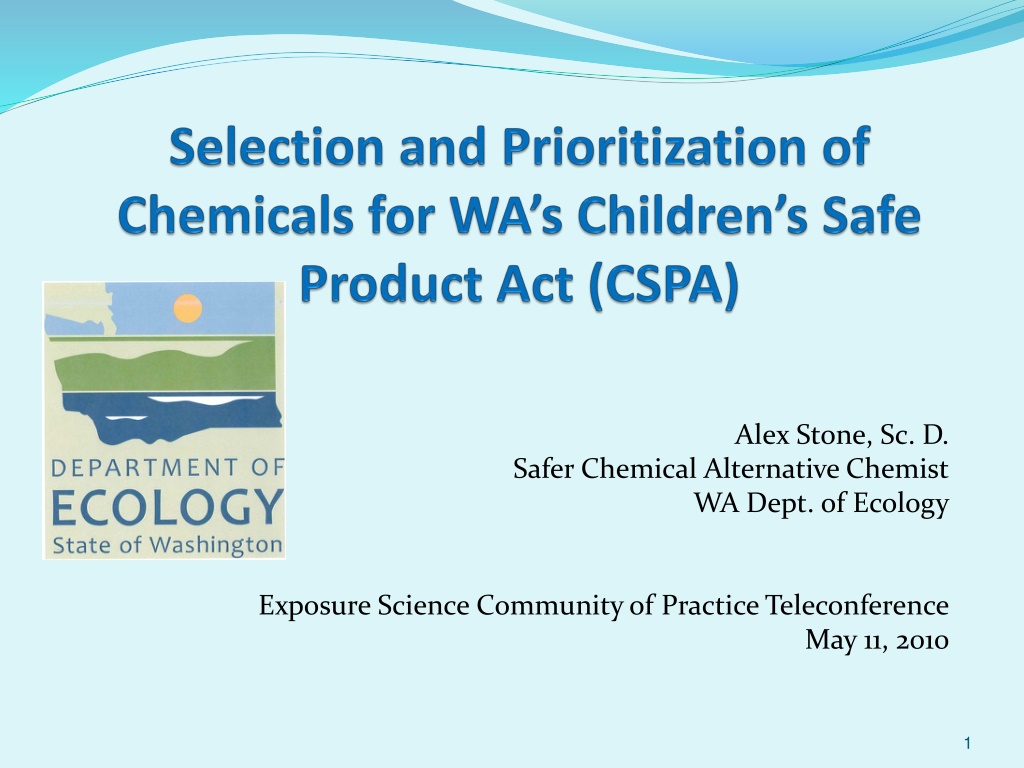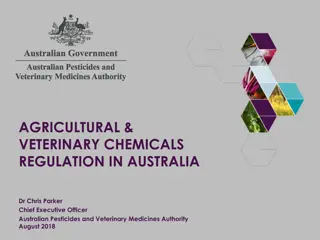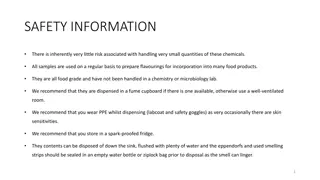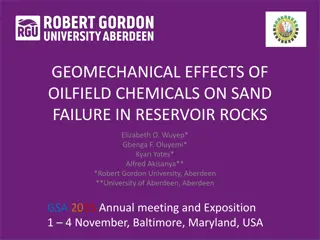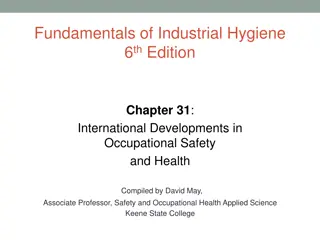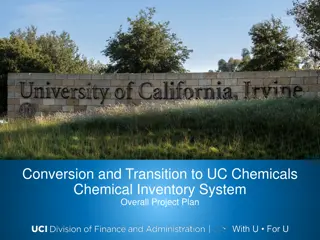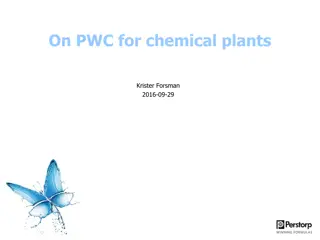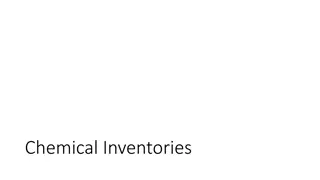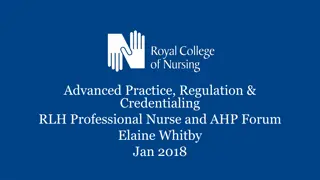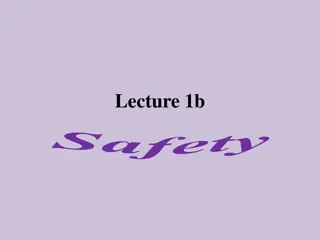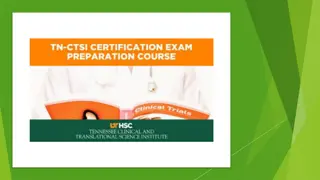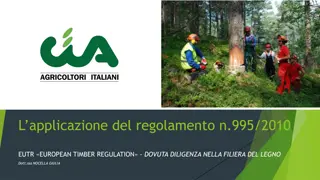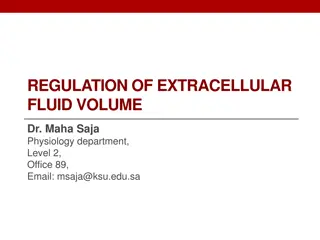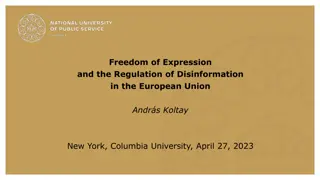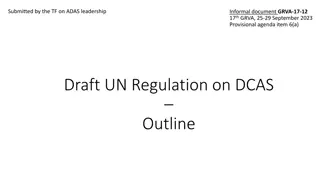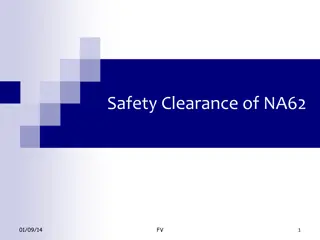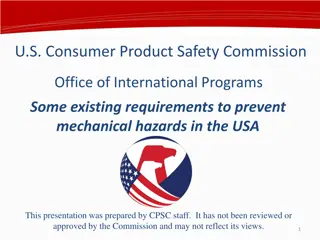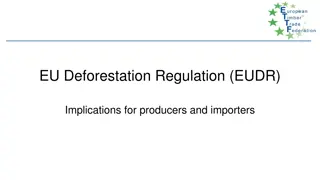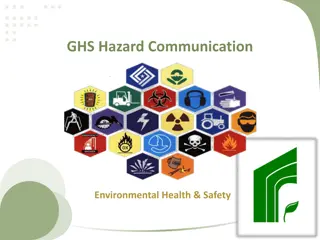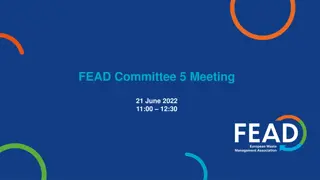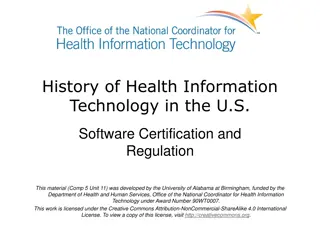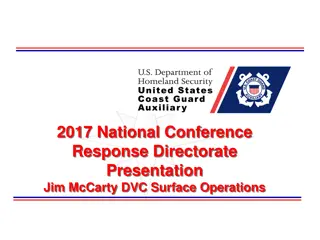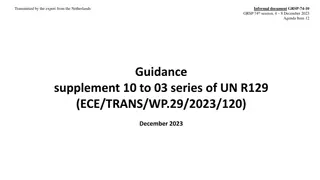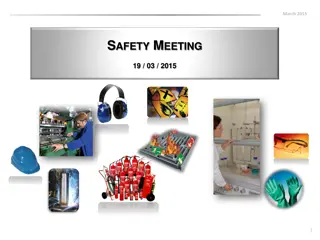Regulation of Chemicals in Children's Products for Safety
Massive safety concerns arose in 2007 due to high lead levels in toys, leading to legislation like the Children's Safe Product Act in WA. The Act restricted lead, cadmium, and phthalates in children's products, with a focus on Chemicals of High Concern to Children (CHCCs). The implementation involves phases of identification, prioritization, and regulation of these chemicals. High Priority Chemicals (HPCs) are determined based on criteria like developmental toxins, cancer-causing properties, and other harm indicators. Various sources, including federal agencies and research universities, contribute to identifying these chemicals.
Download Presentation

Please find below an Image/Link to download the presentation.
The content on the website is provided AS IS for your information and personal use only. It may not be sold, licensed, or shared on other websites without obtaining consent from the author. Download presentation by click this link. If you encounter any issues during the download, it is possible that the publisher has removed the file from their server.
E N D
Presentation Transcript
Alex Stone, Sc. D. Safer Chemical Alternative Chemist WA Dept. of Ecology Exposure Science Community of Practice Teleconference May 11, 2010 1
Background Massive recall of toys in 2007 for high lead levels One child died from swallowing lead charm Concerns for many other children from similar exposures Children s Safe Product Act Passed in WA in April 2008 followed by similar legislation in ME, CT, etc. Restricted lead, cadmium and 6 phthalates in children s products Required Ecology to establish a list of chemicals of high concern to children (CHCCs) Any product manufactured or sold in WA containing any CHCC above established limit must be reported to Ecology 2
Background (cont.) Federal Consumer Product Safety Improvement Act passed in August 2008 Preempted state legislation Established less restrictive limits for lead and phthalates Ecology determined CSPA reporting requirements not preempted by federal legislation Continued with process for identifying CHCCs 3
CSPA Implementation Three Phases Identification of Chemicals of High Concern to Children (CHCCs) 2. Prioritization of CHCCs 3. Final review and determination of CHCCs to be placed into regulation 1. 4
Phase 1 Identify High Priority Chemicals (HPC) Identify Chemicals in Potential Exposure Sources Identify Chemicals of High Concern to Children (CHCCs), i. e. chemicals that are: 1. An HPC and 2. Found in at least one of the potential exposure pathways
High Priority Chemicals (HPCs): (From legislation) Section 2: Definitions High priority chemical as identified by: State agency Federal agency Accredited research university Other scientific evidence deemed authoritative by Ecology One or more of the following criteria: a) Developmental toxin b) Cause: Cancer Genetic damage Reproductive harm Endocrine disruptor c) Damage: Nervous system Immune system Organs Other systemic toxicity d) PBT e) vPvB (very persistent & very bioaccumulative) HPCs 6
HPC Sources: United States: Federal United States: State Prop 65-Total Prop 65 Cancer Prop 65 Developmental Prop 65 Female Prop 65 Male WA PBTs International: Europe EU Endocrine Disruptors Cat 1 EU Endocrine Disruptors Cat 2 EU SVHC (Substances of Very High Concern) EU PBTs EU Chemicals identified for Risk Assessment OSPAR Chemicals of Concern OSPAR 1997 Chemicals for Priority Action IARC Group 1 Known Carcinogens IARC Group 2a Probable Carcinogens IARC Group 2b Possible Carcinogens International: Canada Canadian PBiT list 721 509 256 42 60 74 EPA TRI PBT Chemicals EPA VCCEP Nat. Waste Min. Program Priority Chem. National Toxicology Program Reproduction National Tox. Program Carcinogens-Known National Tox. Program Carcinogens-Suspected IRIS Total IRIS 1986 Category A (known) IRIS 1986 Category B1 (probable-humans) IRIS 1986 Category B2 (probable-animal) IRIS 1986 Category C (possible) IRIS 1996 Known/likely IRIS 1999 Carcinogens IRIS 2005 Suggestive Evidence IRIS Other 64 23 33 39 55 181 128 11 5 65 39 8 4 1 423 91 54 16 28 140 306 35 47 52 222 Other Grandjean Neuro/developmental toxicants 201 393 7
Primary Toxicity Criteria Carcinogenicity Source of Information Prop 65 NWMP IARC IRIS NTP Prop 65 VCCEP Grandjean and Landrigan (2006) NTP NWMP ESR SVHC EU ED OSPAR Nr. of HPCs 446 8 321 138 238 414 23 202 39 20 141 10 317 22 DNR toxicity (dev., neurodev. & repro. toxicity) CMR toxicity Endocrine disruption PBT CEPA PBiT TRI NWMP EU PBT SVHC OSPAR WA PBT 393 72 5 61 5 336 75 vPvB SVHC 1 Other (systemic, target organ, etc.) IRIS 423 3710 Total (sum) 2160 Unique (sum) 2044 Unique (CAS) 8
HPC Sources: (cont.) Coordinated with other states like ME although differences exist between state approaches WA included chemicals suspected or possible for some toxicity criteria Did not want these chemicals selected as potential safer alternatives Differentiated between sources Potential emerging chemicals for which the science is not as developed or easily ascertained (in green) Emerging chemicals removed from prioritization process Sources as of October 2008-recent changes not reflected 9
Identify chemicals of high concern to children (CHCCs): (From legislation) Section 4: Identifying high priority CHCCs after considering a child s or developing fetus s potential for exposure to each chemical. One or more of the following criteria: Chemicals found in biomonitoring studies: a) Humans Umbilical cord blood Breast milk Urine Other bodily tissues or fluids b) Chemicals found in: Household dust Indoor air Drinking water Elsewhere in the home c) Added or present in consumer product used or present in the home Exposure 10
Exposure Selection Criteria 1. Generated data in Four Biomonitoring & potential exposure areas Biomonitoring NHANES & Danish Birth Cohort Journal Articles Indoor Air & Dust CA Air Resources Board Journal Articles Drinking Water EPA drinking water standards Journal Articles Consumer Products Primarily Danish and Dutch consumer product studies Separated chemicals found in children s products from those found in general consumer products 11
Exposure Selection Criteria (cont.) 2. Supplemented with scientific, peer-reviewed journals Environmental Health Perspectives Environmental Science & Technology Society of Toxicology Others as appropriate Journals: Environmental Science and Technology: Environmental Health Perspectives: Toxicological Sciences: http://pubs.acs.org/search/advanced http://www.ehponline.org/ http://toxsci.oxfordjournals.org/search.dtl Indoor Air & Dust Indoor Air House Indoor Biomonitoring: Adipose Blood Breast milk Cord serum Human Infant Tissue Urine Dust Home Biomonitoring Blood level Cord blood Placenta Human Exposure Infant Exposure Maternal blood Exposure Drinking water: Drinking water Water supply Public water Water Products: Consumer products Toys Product General: Children Products Child 12
Exposure Selection Criteria (cont.) 3. Papers only from recent years Concerns about methodologies used in older papers Methodologies standardized over recent years 4. Data omitted: Non-scientific sources (NGO, business, etc.) Scientific studies done in third world or developing Exception: Inuits and other aboriginal people, canaries in the coal mine Limited papers on specific chemicals once presence established Don t need hundreds of papers on PCBs, PBDEs, chlorinated pesticides, etc. If covered in primary sources, not added to work Consider adding additional papers but low priority 13
Exposure Chemical Results Exposure Information Source Number of Chemicals Biomonitoring Studies Drinking Water Indoor Air and House Dust Consumer Products 280 239 290 1,798 2,607 Total 2,419 Unique (sum) 2,219 Unique (CAS) 14
Phase 2 Governor s veto message directed Ecology to place greater emphasis upon chemicals found in children s products Prioritized products based upon 3 toxicity criteria of most importance to children and presence in children s products Used a weight-of-evidence approach 16
Phase 2 (cont.) Chemicals removed before further prioritization: 476 178 17
Phase 2 (cont.) Toxicity criteria I. Developmental or reproductive toxicity II. Endocrine Disruption III. Carcinogenicity Evidence of high toxicity concerns for ANY endpoints (I, II III)? Evidence of moderate toxicity concerns for ANY endpoints (I, II, III)? Evidence of low toxicity concerns for ANY endpoints (I, II, III)? No* No* No* Yes Yes Yes Worst Severe Bad NI * Includes unable to classify Process created by Catherine Karr, MD, PhD, Dept. of Pediatrics and Dept. Environmental & Occupational Health Sciences, University of Washington 18
Phase 2 (cont.) I. Developmental or Reproductive Toxicity No Info Value or Comment Worst Severe Bad No 1. Prop 65 Identified as developmental toxicant NTP CERHR finding Clear or some evidence of adverse effects in humans Limited evidence in humans or some evidence in animals Limited evidence in animals Some or clear evidence of no observable adverse effects EU Existing Substances Identified as Category 1, 2 or 3 GHS Identified as Category 1A, 1B or 2 for reproductive toxicity or germ cell mutagenicity REPROTEXT Rated as A+, A, A-, B+, B, B-, C, D, E, F LOAEL or RTECS TDLo or TCLo Oral value (mg/kg-bw/day) Dermal value (mg/kg-bw/day) Inhalation (vapor) value (mg/L/day) Inhalation (dust/mist/fume) value (mg/L/day) Inhalation (gas) value (ppm/day) Yes No NI 2. Yes Yes Yes Yes 3. Cat 1 Cat 2 Cat 3 NI 4. Cat 1A Cat 1B Cat 2 NI 5. A+, A A-, B+ B E, F B-, C, D 6. < 50 < 100 < 1.0 < 0.1 < 50 50 - 250 100 - 500 1.0 - 2.5 0.1 - 0.5 50 - 250 > 250 > 500 > 2.5 > 0.5 > 250 NI NI NI NI NI 19
Phase 2 (cont.) I. Evidence suggests presence of this chemical in children s products Exposure Criteria Known Possible Unlikely II. Evidence suggests concern for individual child exposure from product with this chemical Known Possible Unlikely Middle Top Priority Top Middle Priority Top Priority No Change Middle Low Priority III. Evidence suggests concern for widespread population level exposure to this chemical Known Possible Unlikely Process created by Catherine Karr, MD, PhD, Dept. of Pediatrics and Dept. Environmental & Occupational Health Sciences, University of Washington Top No Priority change Top Middle Priority Middle Top Priority Middle Lowest Priority Lowest Middle Priority Lowest No Priority 20
Phase 2 (cont.) I. Presence in a child product No Info Value or Comment Known Possible Unlikely No 14. Found in Danish EPA or Dutch studies and reports Yes NI 15. EU or authoritative Risk Assessment indicating use in children s products Yes NI 16. Evidence in data in HSDB indicating possible use in children s products Yes NI 17. Environmental Working Group database if used in cosmetics or sunscreens Yes NI 18. EPA s Inventory Use and Reporting database (IUR) Yes NI 19. NLM Household products database Yes NI 21
Phase 2 (cont.) Segregated 178 potential CHCCs into the following bins Exposure Known Possible Unlikely T o x Worst WK WP WU SK SP SU Severe Bad BK BP BU Reduced 178 potential CHCCs to 65 22
50-00-0 57-55-6 60-29-7 62-53-3 62-75-9 71-36-3 71-43-2 75-01-4 75-07-0 75-09-2 75-15-0 78-93-3 79-34-5 79-94-7 80-05-7 84-66-2 84-75-3 85-44-9 86-30-6 87-68-3 94-13-3 94-26-8 95-53-4 95-80-7 99-76-3 99-96-7 100-41-4 100-42-5 104-40-5 106-47-8 107-13-1 107-21-1 Formaldehyde Propylene glycol Diethyl ether 108-88-3 108-95-2 109-86-4 110-80-5 115-96-8 118-74-1 119-93-7 120-47-8 123-91-1 127-18-4 131-11-3 131-55-5 140-66-9 140-67-0 149-57-5 556-67-2 608-93-5 842-07-9 872-50-4 1163-19-5 1763-23-1 1806-26-4 4376-20-9 5466-77-3 7439-97-6 7439-98-7 7440-36-0 7440-38-2 7440-41-7 7440-48-4 25013-16-5 25154-52-3 Toluene Phenol 2-Methoxyethanol Aniline Ethylene glycol monoethyl ester TCE; Tris-(2-chlorethyl)-phosphate Hexachlorobenzene; HCB 3,3 - Dimethylbenzidine N-nitrosodimethylamine 1-Butanol Benzene Vinyl chloride Acetaldehyde Methylene chloride Carbon disulfide Methyl ethyl ketone 1,1,2,2-Tetrachloroethane TBBPA; Tetrabromobisphenol A Ethyl paraben 1,4-Dioxane Perchloroethylene; Tetrachlorethylene Dimethyl phthalate Benzophenone-2 4-tert-Octylphenol Estragole Bisphenol A 2-Ethyl hexanoic acid Octamethylcyclotetrasiloxane PeCB; pentachlorobenzene C.I. Solvent Yellow 14 1-Methyl-2-pyrrolidinon; NMP BDE 209; Deca-BDE DEP; Diethyl phthalate di-n-hexylphthalate Phthalic anhydride N-nitroso-diphenylamine Hexachlorobutadiene n-Propyl paraben Butyl paraben 2-Aminotoluene 2,4-Toluenediamine Methyl paraben 4-Hydroxybenzoic acid Ethyl benzene PFOS 4-Octylphenol MEHP; Mono-2-ethylhexyl phthalate 2-Ethylhexyl-p-methoxycinnamate Mercury & mercury compounds Molybdenum & Molybdenum compounds Antimony & Antimony compounds Arsenic & Arsenic compounds Beryllium & Beryllium compounds Cobalt & Cobalt compounds Butylated Hydroxyanisole; BHA Styrene 4-n-Nonylphenol; n-NP Chloroaniline Acrylonitrile 1,2-Ethandiol; Ethylene glycol Nonylphenol 25637-99-4 HBCD; Hexabromocyclododecane 23
Phase 3 Final review of 65 CHCCs to determine those placed into regulation Four components part of final determination: 1. Final toxicity and exposure review 2. Determination of a reasonable analytical method 3. Determination of a reporting level 4. Overall policy review In the meantime conducting Pilot Rule 24
Pilot Rule Create draft rule Work with regulated community and interested parties to evaluate effectiveness of proposed rule Based upon input, propose final rule which will contain final list of CHCCs Undergo formal public comment process Once finalized, any product sold or manufactured in WA must report to Ecology presence of chemical in product and certain additional information 25
Links Children Safe Product Act & Pilot Rule Process: http://www.ecy.wa.gov/programs/swfa/rules/ruleChildSa fePilot.html Phase 1 process, Stone and Delistraty, 2009, Sources of toxicity and exposure information for identifying chemicals of high concern to children : http://www.sciencedirect.com/science?_ob=ArticleURL& _udi=B6V9G-4Y5H5XP- 1&_user=10&_rdoc=1&_fmt=&_orig=search&_sort=d&_d ocanchor=&view=c&_acct=C000050221&_version=1&_ur lVersion=0&_userid=10&md5=6cbd6a426cb849743c8d2 7f7da883874 26
Contacts Alex Stone Safer Chemical Alternative Chemist Washington State Dept. of Ecology alex.stone@ecy.wa.gov Phone: (360) 407-6758 27
